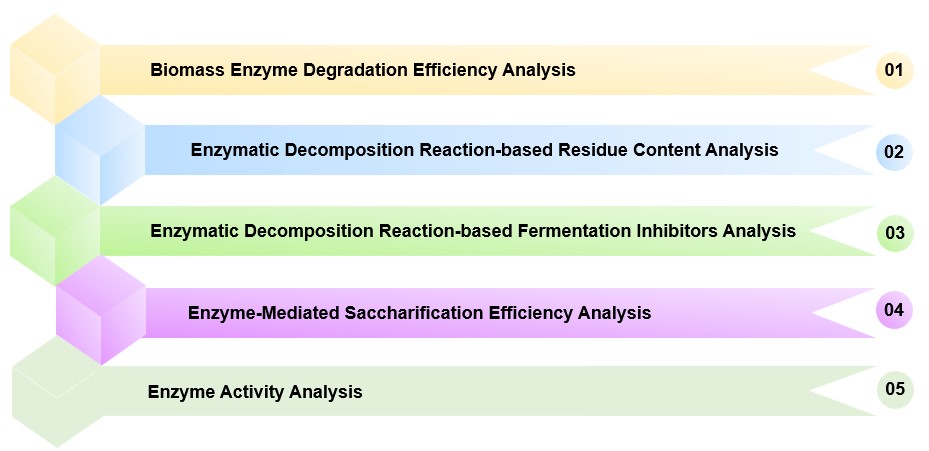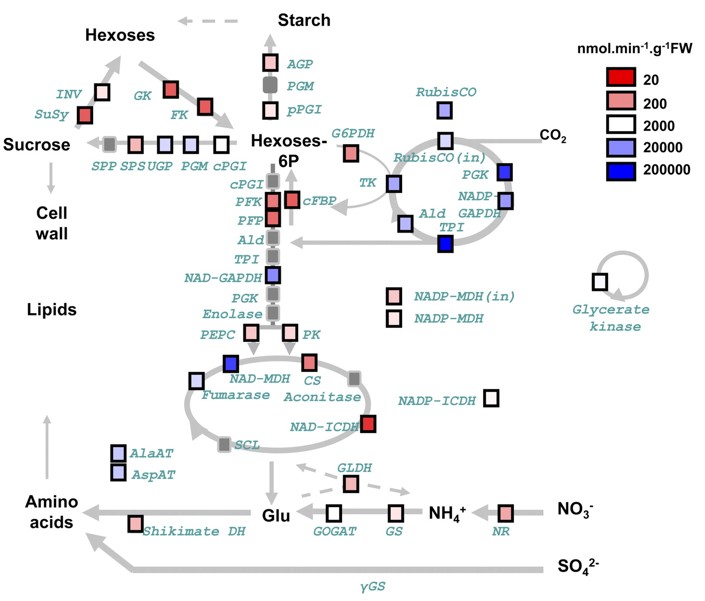Glyan-related Enzyme Activity Analysis Services
Tailor-made Enzyme Activity analytical solutions at Creative Biolabs
Enzymes play a vital role in the conversion of biomass into biofuels and bioproducts. Enzymes act as biocatalysts, which are applied to convert the structural polymers of biomass into monomers, which are subsequently passed through microorganisms such as yeast or bacteria to ferment it into the required fuel. Creative Biolabs provides a series of enzyme activity analysis services. Accurate enzyme activity data not only helps to improve bioconversion efficiency and yield but also promotes the sustainable utilization of biomass resources. We help clients evaluate the conversion potential of biomass, optimize pretreatment processes, identify fermentation inhibitors, guide process design, and provide support for client decision-making.
Enzyme digestibility analysis uses specific enzymes to simulate the digestion process of biomass, thereby analyzing the degradation performance of biomass by evaluating the yield of soluble sugars in the digestive juice, thereby guiding the effective utilization of biomass resources. We complete the enzymatic digestibility analysis of biomass by providing analysis for sugars and other degradation products in a variety of digestive juices. Such as total sugar, glucose, mannose, cellobiose, etc.
After the enzymatic hydrolysis reaction, the biomass will leave residue components including cellulose, lignin, hemicellulose, and so on. Creative Biolabs has developed a comprehensive analysis process, covering sample preparation, residue component extraction, and quantitative analysis of residues including monosaccharides, polysaccharides, organic matter, etc., to provide in-depth and accurate analysis results for the residues after enzymatic hydrolysis. By analyzing the composition of these residues, the enzymatic hydrolysis efficiency is effectively evaluated, the unhydrolyzed structural polysaccharide content is revealed, and relevant information is provided for decision-making.
We provide fermentation inhibitors analysis services in enzyme hydrolysates. Common inhibitors such as formic acid, acetic acid, furfural, and phenols may affect the microbial fermentation process. We extract the fermentation inhibitors from the enzymatic hydrolyzate and then separate and quantitatively detect various fermentation inhibitors through chromatography-mass spectrometry technology. Analyzing these inhibitors helps clients reduce their inhibitory effect on the fermentation process, thereby improving production quality.
The efficiency when the substrate polysaccharide is hydrolyzed by the enzyme into various monosaccharides is called enzyme saccharification efficiency, which is affected by factors such as enzyme activity, substrate hydrolysis rate, and product monosaccharide concentration. We provide saccharification efficiency analysis for a series of enzymes such as amylase, xylanase, and cellulase. We first mix the enzyme to be tested with the corresponding substrate to allow enzymatic hydrolysis reaction, and then detect the monosaccharide content after enzymatic hydrolysis through spectrometry, chromatography, and mass spectrometry to complete the evaluation of enzyme saccharification efficiency. This analysis helps determine the optimal reaction conditions and enzyme dosage during process production, thereby optimizing the process flow.
In addition, Creative Biolabs has set up a testing laboratory focused on enzyme activity analysis, with a professional technical team providing activity assessment for various enzymes and decomposing enzymes, such as Cellulase, Cellulolytic Enzymes, Sucrase, and Amylolytic Enzymes Activity Analysis services. By evaluating the activity of these enzymes, we help clients understand the efficiency and speed of cellulose and starch degradation, thereby improving substrate conversion and achieving a more efficient production process.
 Fig.1 Glyan-related enzyme activity analysis services.
Fig.1 Glyan-related enzyme activity analysis services.
Creative Biolabs provides professional enzyme activity analysis services to help you deeply understand the key role of enzymes in biological processes. Whether you need to evaluate enzyme activity, optimize saccharification processes, or improve fermentation product quality, we provide you with tailor-made analytical solutions. Please contact us and let us help you optimize your production process and achieve more efficient production and resource utilization!
Published data
The author selected Arabidopsis Accessions as the research object, measured the catalytic activities of 35 enzymes in different metabolic pathways, and established a matrix to explore the intra-species connections between enzymes, metabolites, and biomass. The participating pathways of various enzymes and their maximum catalytic activity (shown by color coding) are listed in the figure below. In this study, the authors first used a ball mill pre-cooled with liquid nitrogen to homogenize Arabidopsis Accessions buds, then performed chemical derivatization, used GC-MS to analyze metabolites and enzyme activities, and performed statistical analysis of the results. The results showed that there was a high correlation between enzyme activities, while there was no obvious correlation between enzyme activities and metabolites. This study helps us systematically understand the natural changes in enzyme activity in different metabolic pathways.
 Fig.2 The participating pathways of various enzymes and their maximum catalytic activity.1, 2
Fig.2 The participating pathways of various enzymes and their maximum catalytic activity.1, 2
FAQs
Q1: When performing enzymatic biomass analysis, how do you determine the degradability of the biomass and the most effective enzyme types and amounts?
A1: When conducting biomass enzymatic hydrolysis analysis, we will determine its degradability by evaluating the enzymatic hydrolysis rate and enzymatic hydrolysis product composition of the biomass. For different biomass types, we will select the appropriate enzyme type and optimal dosage for testing to ensure the most efficient enzymatic hydrolysis effect.
Q2: In the analysis of residue composition after enzymatic hydrolysis, how to determine the composition of various residues formed during biomass hydrolysis?
A2: We use chemical analysis techniques, such as chromatography, mass spectrometry, etc., to analyze the components of the residue after enzymatic hydrolysis. We determine the composition of various residues formed during the hydrolysis of biomass, thereby evaluating the effect of enzymatic hydrolysis.
Q3: How to evaluate the saccharification efficiency of enzymes and determine the optimal reaction conditions?
A3: Enzyme saccharification efficiency analysis is used to evaluate the saccharification efficiency of enzymes and determine the optimal reaction conditions and enzyme dosage. Through a series of steps such as experimental design, sample pretreatment, substrate mixing, enzymatic hydrolysis reaction, and product concentration determination, we effectively evaluate enzyme activity and hydrolysis efficiency and provide clients with optimization suggestions.
Customer Review
Accurate Analysis
"The analysis of residue composition after enzymatic hydrolysis provided by Creative Biolabs enables us to fully understand the composition of the residue after enzymatic hydrolysis, which helps us optimize the waste treatment process and achieve a more environmentally friendly production model. Thank you for your accurate analysis of data and suggestions! "
Optimize Process Flow
"The amylolytic enzymes activity analysis conducted by Creative Biolabs helps us determine the activity level of amylolytic enzymes and provides a solid foundation for the improvement of our starch processing technology. Thank you very much for your team's professional support and help!"
References
-
Sulpice, Ronan, et al. "Network analysis of enzyme activities and metabolite levels and their relationship to biomass in a large panel of Arabidopsis accessions." The Plant Cell 22.8 (2010): 2872-2893.
-
Under Open Access license CC BY 4.0, without modification.
For Research Use Only.
Related Services

 Fig.1 Glyan-related enzyme activity analysis services.
Fig.1 Glyan-related enzyme activity analysis services.
 Fig.2 The participating pathways of various enzymes and their maximum catalytic activity.1, 2
Fig.2 The participating pathways of various enzymes and their maximum catalytic activity.1, 2



